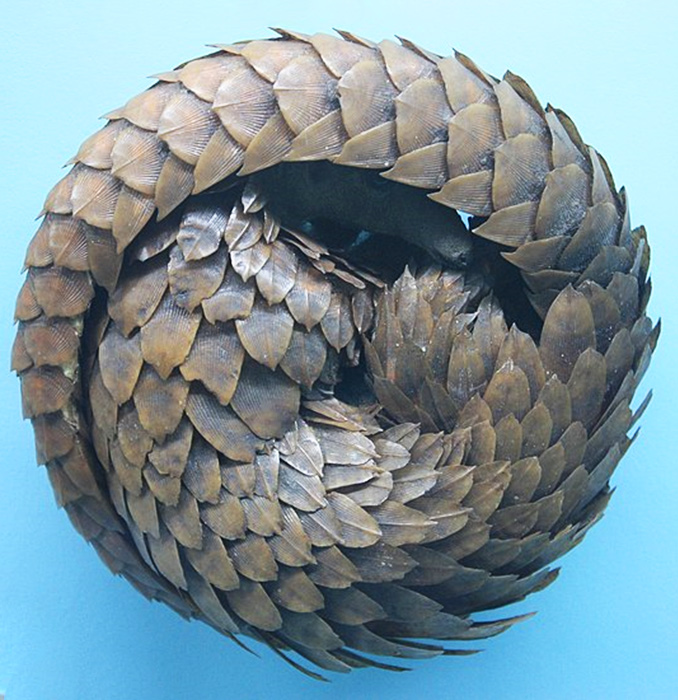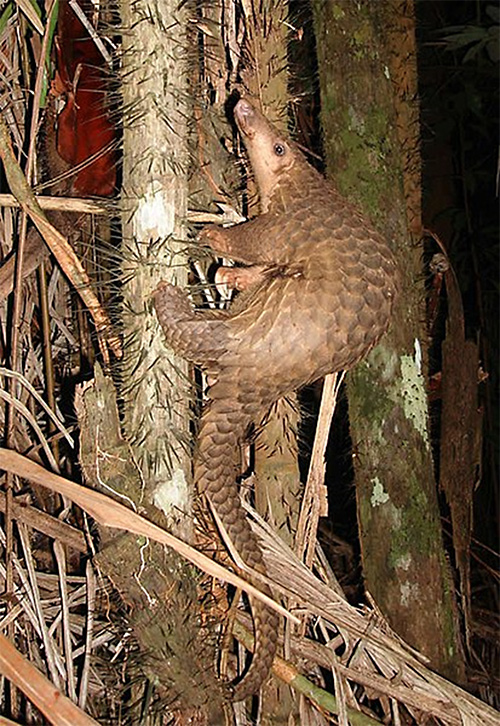
The pangolin is one of the world’s most unusual animals—and one of the most heavily poached.
An adult pangolin is 3 to 5 feet long and eats some 70 million ants and termites a year, using a tongue that’s longer than its body, covered in sticky saliva.
It burrows into termite mounds and anthills and can close its ears and nostrils to keep angry ants at bay.
That may sound like an anteater or an aardvark. Except, the pangolin is completely covered in scales. It’s the only mammal that has them.
These scales are made of keratin, just like our fingernails. A single pangolin could have more than a thousand, making up 20 percent of its body weight.
Pangolins roll into a ball when threatened—the sharp edges of their scales providing extra protection, even against lions.
But that’s not enough to keep human predators away.
The pangolin’s scales are valued in Asian folk medicines, even though they’ve been proven to be no more medicinal than an old toenail.
Their meat is eaten in Asia as a delicacy. Even their blood is considered an aphrodisiac.
So, poachers catch and kill them, which has made all eight species critically endangered or vulnerable.
In the last 10 years, customs agents have confiscated literally tons of pangolin scales, which came from more than 1 million animals.
World Pangolin Day is February 15. You probably don’t buy pangolin products yourself, but raising awareness for this remarkable, gentle animal can support its protection.
Background
Synopsis: Pangolins are insectivores that may look like anteaters or armadillos, but they are more closely related to dogs or bears. They are Earth’s only scale-covered mammals. Their meat is considered a delicacy and their fingernail-like scales are used in Thai, Chinese and Vietnamese folk medicine. There are eight species of pangolins. These gentle, shy creatures are the world’s most trafficked animals.

- Pangolins are covered in overlapping platelike scales made of keratin, just like our fingernails. They are the only mammals with scales, making them unique, and vulnerable to poaching.
- They roll up in scale-armored balls like armadillos when threatened. The sharp edges of their scales provide defense, but when threatened, pangolins can also spray a noxious liquid like a skunk.
- They look like giant pinecones on stumpy legs. Their scales account for more than 20% of their weight: Each pangolin has about 1,000 scales.
- They can toddle on their back legs or use all four legs to move about their ranges, and they are good swimmers.
- When full grown, the different species range from 32 to 70 in (80 to 180 cm) from the tips of their noses to the ends of their tails.
- They have no teeth. Like birds, they swallow gravel to help with “chewing” their prey, and their lower stomachs have hard spines that point inward.
- Both their tails and their tongues may be longer than their bodies. Their tongues start in their chest cavities between the sternum and the trachea. They are covered with sticky saliva that traps insects.
- Pangolins eat termites and ants—more than 70 million per year—like anteaters. They especially love larvae and can close their noses and ears to keep attacking insects out.
- They are nocturnal and dig into mounds or scrape off tree bark with their big claws in search of prey.
- Some species inhabit underground burrows up to 11 ft (3.4 m) deep, and others live in hollow trees.
- Mother pangolins have only one baby per year. They carry their babies on their tails and backs up until they are 2 years old.
- We don’t know how long they live in the wild, but pangolins have lived up to 20 years in captivity.
- Pangolins have their own order, Pholidota, but there are eight remaining species of pangolin, all of which are considered vulnerable to critically endangered.
Four live in Tropical Asia:
- Indian pangolin (also called thick-tailed pangolin), Manis crassicaudata—Endangered
- Philippine pangolin (also called Palawan pangolin), Manis culionensis—Endangered
- Sunda pangolin (also called Malayan or Javan pangolin), Manis javanica—Critically Endangered
- Chinese pangolin, Manis pentadactyla—Critically Endangered
Four others live in sub-Saharan Africa:
- Tree pangolin (also called white-bellied or three-cusped pangolin), Phataginus tricuspis—Vulnerable
- Giant ground pangolin, Smutsia gigantea—Vulnerable
- Ground pangolin (also called Temminck’s pangolin), Smutsia temminckii—Vulnerable
- African black-bellied pangolin (also called long-tailed pangolin), Uromanis tetradactyla—Vulnerable
- Nearly all pangolins’ body parts are sold on the black market.
- Their scales are made into jewelry, used to decorate clothing, or ground into powder for medicinal use. Business ventures have falsely claimed that pangolin medicines can cure cancer, but scientific studies show they have no medicinal properties.
- Their meat is an Asian delicacy; pangolin fetuses may be made into a special soup in Asia.
- Their blood is thought to be an aphrodisiac, so it is dried and added to potions.
- In the early 1990s, pangolin meat was worth $4.50/lb ($10/kg), and by 2011 it had increased 20 times to $90/lb ($200/kg).
- In 2015, pangolin scales were worth $1,365/lb ($3,000/kg).
- Experts estimate that more than a million pangolins were poached in recent decades, and demand is growing. As Asian pangolins become more difficult to find, poachers are turning to their African cousins.
- Two major seizures of African pangolin scales occurred in April 2019 in Singapore; the first was 14.2 tons and the second was 14 tons—representing more than 72,000 pangolins.
- Prior to that, the largest seizure was 13.1 tons of scales in November 2017 in Shenzhen, China, harvested from more than 30,000 pangolins.
- Reported seizures from 2011-2013 came from 117,000-234,000 pangolins.
- INTERPOL suggests these seizures represent only 10% of illegal trade volumes.
- International treaties exist to prohibit trade in the Asian species and to restrict trade in the African species, but the black market continues to drive poaching.
- The third Saturday in February is World Pangolin Day, to promote conservation. In 2020, it will be celebrated on February 15.
- Jackie Chan of martial arts and movie fame is the WildAid and Nature Conservancy ambassador for pangolins; he created a video spot to increase awareness about the plight of the pangolin in 2017.
- Chan’s message is: “When the buying stops, the killing can too.”

